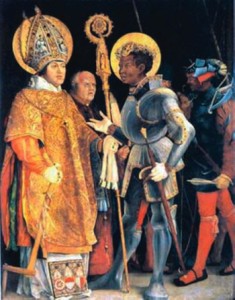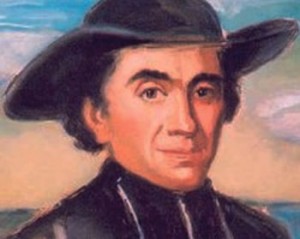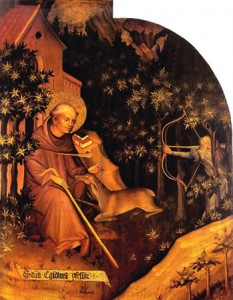September Saints
Giles, a popular saint of the Middle Ages, was born in Athens, Greece, and became the abbot of a monastery on the Rhône River.
When as a young man he met a poor beggar who was sick and half-naked, he was moved with compassion and gave him his splendid tunic; the moment the beggar put it on, he found himself in perfect health. Shortly afterwards, Giles distributed all his goods to the poor and entered upon a life of poverty, suffering and humility. Soon, as miracles multiplied, it became impossible for him to live in obscurity and retirement, which he desired above all else. He therefore went to France and chose for his hermitage the open spaces of the south, near the mouth of the Rhône.
A tradition explains his emblem – a hind. He was kept company in his hermitage by a deer which had sought refuge from the hunting party of a king of the Goths. A hunter discovered Giles, pierced by an arrow, holding the deer.
The king erected a monastery for Giles, and Charlemagne sent for him to serve as his confessor. He died in 720.
Saint Giles, give us a Christ-like generosity towards the needy.
(Sources: Internet (various); Encyclopedia of the Saints, Matthew, Margaret & Stephen Bunson.1998 Our Sunday Visitor Publishing, Indiana)
 Saint Maurice and the Theban Legion (d. 286)
Saint Maurice and the Theban Legion (d. 286)
According to the legend, the Theban Legion consisted of Christian soldiers recruited in Upper Egypt.
While on service in Gaul, they were camped near the Lake of Geneva, when they received orders to join with the others in a solemn sacrifice to the gods. They retired a little farther away in order to abstain, but were told to return and join in the festival with the others. They refused and were decimated.
The survivors persisted in declaring themselves Christians, and the butchery began again. The men all persevered in their faith, and Saint Maurice sent to the tyrant a letter, saying: “Emperor, we are your soldiers; we are ready to combat the enemies of the empire, but we are also Christians, and we owe fidelity to the true God. We are not rebels, but we prefer to die, innocent, rather than to live, guilty.” The Emperor, seeing himself defeated, ordered them all to be massacred.
Saint Maurice, give us the courage of our convictions.
(Encyclopedia of the Saints, Matthew, Margaret & Stephen Bunson.1998 Our Sunday Visitor Publishing, Indiana)
 Blessed Pierre Bonhomme (1803-1861)
Blessed Pierre Bonhomme (1803-1861)
Born in 1803 in Gramat, France, Pierre was a pious and studious child who early felt a call to the priesthood and was attracted to a life of simplicity and poverty. He entered the seminary at Montfaucon in November 1818 at age 15. Ordained a priest in 1827, he demonstrated an extraordinary ability to help others, both spiritually and materially.
Shortly after his appointment as parish priest of Gramat, Father Bonhomme came into contact with the wretchedness and neglect suffered by so many of the poor, elderly and sick whom he longed to help. He urged his young people to visit them, bringing material and spiritual comfort. Shortly afterward, he established a home for the needy, founding the Congregation of the Sisters of Our Lady of Calvary to serve them. The Congregation was dedicated to educating children and to providing assistance to the poor, sick, elderly and physically disabled.
Father Bonhomme continued his parish activity and was known for the many missions he preached. A gifted preacher, he converted many and attracted other young women to his congregation. He had a special devotion to Our Lady of Rocamadour, through whose intercession he was miraculously cured of having completely lost his voice while preaching a retreat.
After a retreat in a Trappist monastery, Pierre felt a growing desire to become a Carmelite and to found a Carmelite monastery in Gramat, but his Bishop insisted that he continue his work as a missioner and gave him a new group of missioners to work with. This he did until a disease of the larynx forced him to stop. His mission vocation over, Father Pierre turned his attention to the Congregation, expanding their work into care for the deaf and mute in 1854 and the mentally ill in 1856.
In his last years, Father Bonhomme devoted all his time and energy to forming the Sisters and to writing the Rule of his Institute. He died in Gramat on 9 September 1861.
Blessed Pierre, open our hearts to the needs of others.
(Source: Internet – various)

 Entries(RSS)
Entries(RSS)